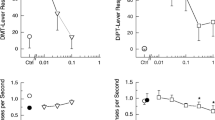Abstract
Administration of lithium chloride (10 mmol/kg on day 1 and 3 mmol/kg twice daily on subsequent days, SC) for 3–14 days enhances the components of the serotonin syndrome produced by 8-hydroxy-2-(di-propylamino)tetralin (8-OH-DPAT) in the rat. The hypothermic response produced simultaneously was unaltered. Following lithium administration for 3 days the motor response to 5-methoxy,N,N-dimethyltryptamine was also facilitated. These data suggest that lithium administration enhances post-synaptic 5-HT receptor-mediated behavioural responses.
(−)-Propranolol (20 mg/kg, IP) but not (+)-propranolol (20 mg/kg IP) fully antagonised the facilitated response to 8-OH-DPAT seen following lithium administration; ritanserin (200 μg/kg, IP) was without effect. These findings favour a mechanism for the action of lithium involving the 5-HT1A receptor.
Depletion of 5-hydroxytryptamine (5-HT) with parachlorophenylalanine (PCPA, 300 mg/kg, IP on day 1 and 2 of lithium administration) did not prevent the facilitation by lithium of the response to 8-OH-DPAT. These data strengthen the suggestion that lithium has its effect on 5-HT1A-mediated motor function by a post-synaptic action.
By contrast, motor responses to the putative 5-HT1B receptor agonist 5-methoxy-3-(1,2,3,6-tetrahydro-pyridin-4-yl)-1H-indole (RU 24969) were unaltered by repeated lithium administration.
Similar content being viewed by others
References
Allison JH, Blisner ME, Holland WH, Hipps PP, Sherman WR (1976) Increased myo-inositol 1-phosphate in lithium treated rats, Biochem Biophys Res Commun 71:664–669
Bedard P, Pycock CJ (1977) “Wet-dog” shake behaviour in the rat; a possible quantitative model of central 5-hydroxytryptamine activity. Neuropharmacology 16:663–670
Berridge MJ, Downes CP, Hanley MR (1982) Lithium amplifies agonist-dependent phophatidylinositol responses in brain and salivary glands, Biochem J 206:587–595
Blier P, de Montigny C (1985) Short-term lithium administration enhances serotonergic neurotransmission; electrophysiological evidence in rat CNS. Eur J Pharmacol 113:69–77
Deakin JFW, Green AR (1978) The effects of putative 5-hydroxytryptamine antagonists on the behaviour produced by administration of tranylcypromine and L-tryptophan or L-dopa to rats. Br J Pharmacol 64:201–209
Godfrey PP, Minchin MCW, McClue SJ, Young MM (1985a) RU 24969, a 5-HT1 agonist, stimulates inositol phospholipid breakdown in rat brain slices. Br J Pharmacol 84:112P
Godfrey PP, Minchin MCW, McClue SJ, Young MM (1985b) 8-OH-DPAT stimulates inositol phospholipid breakdown in rat brain slices and rabbit platelets. Br J Pharmacol 86:446P
Goodwin GM, Green AR (1985) A behavioural and biochemical study in mice and rats of putative agonists and antagonists for 5-HT1 and 5-HT2 receptors. Br J Pharmacol 84:743–753
Goodwin GM, DeSouza RJ, Wood AJ, Green AR (1986) Lithium decreases 5-HT1A and 5-HT2 receptor and α2-adrenoceptor mediated junction in mice. Psychopharmacology 90:482–487
Grahame-Smith DG, Green AR (1974) The role of brain 5-hydroxytryptamine in the hyperactivity produced in rats by lithium and monoamine oxidase inhibitors. Br J Pharmacol 52:19–26
Green AR, Heal DJ (1985) The effects of drugs on serotonin-mediated behavioural models. In: Green AR (ed) Neuropharmacology of serotonin. Oxford University Press, Oxford, pp 326–365
Hjorth S, Carlsson A, Lindberg P, Sanchez D, Wikstrom H, Arvidsson L-E, Hacksell U, Nilsson JLG (1982) 8-Hydroxy-2-(di-n-propylamino) tetralin, 8-Oh-DPAT, a potent and selective simplified ergot congener with central 5-HT-receptor stimulating activity. J Neural Transm 55:169–188
Honchar MP, Olney JW, Sherman WR (1983) Systemic cholinergic agents induce seizures and brain damage in lithium-treated rats. Science 220:323–325
Lucki I, Frazer A (1982) Prevention of the serotonin syndrome in rats by repeated administration of monoamine oxidase inhibitors but not tricyclic antidepressants. Psychopharmacology 77:205–211
Lucki I, Nobler MS, Frazer A (1984) Differential actions of serotonin antagonists on two behavioural syndromes of serotonin receptor activation in the rat. J Pharmacol Exp Ther 228:133–139
Maggi A, Enna SJ (1980) Regional alterations in rat brain neurotransmitter systems following chronic lithium treatment. J Neurochem 34:888–892
Middlemiss DN, Fozard JR (1983) 8-hydroxy-2-(di-n-propylamino) tetralin discriminates between subtypes of the 5-HT1 recognition site. Eur J Pharmacol 90:151–153
Middlemiss DN, Blackborough L, Leather SR (1977) Direct evidence for an interaction of β-adrenergic blockers with the 5-HT receptor. Nature 267:289–290
Sheard MH, Aghajanian GK (1970) Neuronally activated metabolism of brain serotonin: effect of lithium. Life Sci 9:285–290
Sills MA, Wolfe BB, Frazer A (1984) Determination of selective and non-selective compounds for the 5-HT1A and 5-HT1B receptor subtypes in rat frontal cortex. J Pharmacol Exp Ther 231:480–487
Stolz JF, Marsden CA, Middlemiss DN (1983) Effect of chronic antidpressant treatment and subsequent withdrawal on [3H]-spiperone binding in rat frontal cortex and serotonin receptor mediated behaviour. Psychopharmacology 80:150–155.
Treiser SL, Cascio GS, O'Donohue TL, Thoa NB, Jacobowitz DM, Kellar KJ (1981) Lithium increases serotonin release and decreases serotonin receptors in hippocampus. Science 213:1529–1531
Tricklebank MD, Forler C, Fozard JR (1984) The involvement of subtypes of the 5-HT1 receptor and of catecholaminergic systems in the behavioural response to 8-hydroxy-2-(di-n-propylamino) tetralin in the rat. Eur J Pharmacol 106:271–282
Wood AJ, Goodwin GM, DeSouza RJ, Green AR (1986) The pharmacokinetic profile of lithium in rat and mouse; an important factor in psychopharmacological investigation of the drug. Neuropharmacology (in press)
Author information
Authors and Affiliations
Rights and permissions
About this article
Cite this article
Goodwin, G.M., De Souza, R.J., Wood, A.J. et al. The enhancement by lithium of the 5-HT1A mediated serotonin syndrome produced by 8-OH-DPAT in the rat: evidence for a post-synaptic mechanism. Psychopharmacology 90, 488–493 (1986). https://doi.org/10.1007/BF00174066
Received:
Revised:
Issue Date:
DOI: https://doi.org/10.1007/BF00174066




